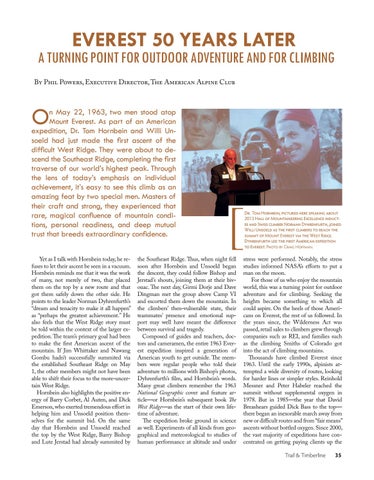EvErEst 50 YEars LatEr
A Turning PoinT for ouTdoor AdvenTure And for Climbing By Phil Powers, Executive Director, The American Alpine Club
O
Yet as I talk with Hornbein today, he refuses to let their ascent be seen in a vacuum. Hornbein reminds me that it was the work of many, not merely of two, that placed them on the top by a new route and that got them safely down the other side. He points to the leader Norman Dyhrenfurth’s “dream and tenacity to make it all happen” as “perhaps the greatest achievement.” He also feels that the West Ridge story must be told within the context of the larger expedition. The team’s primary goal had been to make the first American ascent of the mountain. If Jim Whittaker and Nawang Gombu hadn’t successfully summited via the established Southeast Ridge on May 1, the other members might not have been able to shift their focus to the more-uncertain West Ridge. Hornbein also highlights the positive energy of Barry Corbet, Al Auten, and Dick Emerson, who exerted tremendous effort in helping him and Unsoeld position themselves for the summit bid. On the same day that Hornbein and Unsoeld reached the top by the West Ridge, Barry Bishop and Lute Jerstad had already summited by
]
n May 22, 1963, two men stood atop Mount Everest. As part of an American expedition, Dr. Tom Hornbein and Willi Unsoeld had just made the first ascent of the difficult West Ridge. They were about to descend the Southeast Ridge, completing the first traverse of our world’s highest peak. Through the lens of today’s emphasis on individual achievement, it’s easy to see this climb as an amazing feat by two special men. Masters of their craft and strong, they experienced that rare, magical confluence of mountain conditions, personal readiness, and deep mutual trust that breeds extraordinary confidence.
the Southeast Ridge. Thus, when night fell soon after Hornbein and Unsoeld began the descent, they could follow Bishop and Jerstad’s shouts, joining them at their bivouac. The next day, Girmi Dorje and Dave Dingman met the group above Camp VI and escorted them down the mountain. In the climbers’ then-vulnerable state, their teammates’ presence and emotional support may well have meant the difference between survival and tragedy. Composed of guides and teachers, doctors and cameramen, the entire 1963 Everest expedition inspired a generation of American youth to get outside. The members were regular people who told their adventure to millions with Bishop’s photos, Dyhrenfurth’s film, and Hornbein’s words. Many great climbers remember the 1963 National Geographic cover and feature article—or Hornbein’s subsequent book The West Ridge—as the start of their own lifetime of adventure. The expedition broke ground in science as well. Experiments of all kinds from geographical and meteorological to studies of human performance at altitude and under
Dr. Tom Hornbein, pictured here speaking about 2013 Hall of Mountaineering Excellence inductee and Swiss climber Norman Dyhrenfurth, joined Willi Unsoeld as the first climbers to reach the summit of Mount Everest via the West Ridge. Dyhrenfurth led the first American expedition to Everest. Photo by Craig Hoffman.
stress were performed. Notably, the stress studies informed NASA’s efforts to put a man on the moon. For those of us who enjoy the mountain world, this was a turning point for outdoor adventure and for climbing. Seeking the heights became something to which all could aspire. On the heels of those Americans on Everest, the rest of us followed. In the years since, the Wilderness Act was passed, retail sales to climbers grew through companies such as REI, and families such as the climbing Smiths of Colorado got into the act of climbing mountains. Thousands have climbed Everest since 1963. Until the early 1990s, alpinists attempted a wide diversity of routes, looking for harder lines or simpler styles. Reinhold Messner and Peter Habeler reached the summit without supplemental oxygen in 1978. But in 1985—the year that David Breashears guided Dick Bass to the top— there began an inexorable march away from new or difficult routes and from “fair means” ascents without bottled oxygen. Since 2000, the vast majority of expeditions have concentrated on getting paying clients up the Trail & Timberline
35






